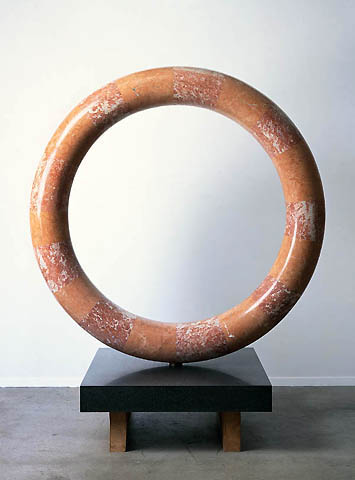I do not agree to the statement that a valid interpretation of an artwork is dependent on an understanding of the artist's intent and the context in which it was created. Interpretation is about what the viewers perceive from the artwork. At the same time, artist's intent and the context in which the artwork was created determines the way that the artist hopes to convey his or her interpretation. A work of art is “a closed form” because it is a “balanced organic whole,” writes Umberto Eco. At the same time, an artwork is open “on account of its susceptibility to countless different interpretations.” Thus, a valid interpretation does not necessarily have to dependent on artist's intent and the context in which it was created. In every reception the work takes on a fresh perspective for itself, thus there might have numerous valid interpretation different from the artist' intentional message.

Isamu Noguchi. Sun at Noon (1969). Red French and pink Spanish marble.
A fifteen-year-old girl has been standing in front of Isamu Noguchi’s Sun at Noon (1969) for some time. When she was asked what’s on her mind.
It is some type of porthole or something. Maybe there’s a whole world in there [that] you can go inside. It’s at the beginning of the [exhibition], so it’s kind of like if we go through this we’re going into this new world.
The circle is important. I see it like, it never really ends...It’s infinite...it keeps on going. If you look at the shape it has no flaws...it’s so controlled. It is like “the civilized”...because stone is rough but the artist smoothed it out, like society [smoothes out] the person. Oh, that also gives me the idea that it’s like “the ideal.” It is illusionary, like it cannot be real...
The girl is not the first person to interpret Sun at Noon. When Noguchi was still alive, one interpreter associated Sun at Noon with Italian Renaissance architecture. Stressing that Noguchi had worked in Italy around the time he made Sun at Noon. However, to the artist, Sun at Noon was nothing more than a feat of engineering. The only thing Noguchi publicly associated the sculpture with was the sun—a reference that transcends cultures, which was absent from Jessica’s response.
The girl was aware of the nature of the object she was looking at: an artwork. She also knew that artworks are meant “to be looked at” and interpreted. In fact, she interacted with the sculpture in accordance to these conventions. Still, there are differences between the original meaning of the work—as articulated by Noguchi—and her interpretation.
It is true that yet in spite of the openness of a work, not every interpretation of an object is valid. For an interpretation to be tenable, the features of the work must support it. For example, Sun at Noon can become a porthole because it frames a round void and because it is placed like a doorway at the beginning of an exhibition. The sculpture can be about “the ideal” because it is a perfect circle, because it has a flawless, smooth surface, and because it is held up in a way that appears to defeat earthly gravity. But to consider if someone interprets that Sun at Noon in relation to, say, uncontained chaos is untenable as there is little in the work’s features to support such an interpretation.
When an artwork is created, the artist knows that he or she will be interpreted not according to his or her intentions but according to the interactions between the artwork and the viewers. These interactions involve the features of the work, the viewers and their environment. An important distinction thus arises between the intentions of the artist—the ideas in an artist’s mind about his or her work—and the “intention of the artwork”—the messages that the object actually conveys as a result of the artist’s choices and actions. These qualities may offer many different interpretation possibilities that the artist did not foresee. In that sense, a work contains its own independent “intent” or set of suggestive experiences.
Thus, the potential meanings of an object derive from the work itself, and are not controlled or limited by the artist’s intention and the context in which it was created. Therefore the viewer “is not obliged to speculate about what happened in the head of the artist”. From this perspective, the girl has no responsibility to make conjectures about what Noguchi might have meant. Her commitment is to the sculpture in its current context (at the beginning of an exhibition), not to the artist. Moreover, the girl is not getting it wrong as she makes sense of the sculpture, even if her ideas differ from Noguchi’s. She is simply bringing new insights to Sun at Noon.